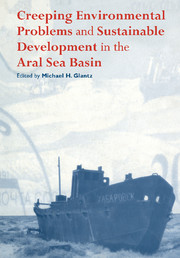Book contents
- Frontmatter
- Contents
- List of contributors
- Introduction
- 1 Sustainable development and creeping environmental problems in the Aral Sea region
- 2 Ecological disaster linked to landscape composition changes in the Aral Sea basin
- 3 Alteration of water level and salinity of the Aral Sea
- 4 Desertification in the Aral Sea region
- 5 Climate fluctuations and change in the Aral Sea basin within the last 50 years
- 6 Priaralye ecosystems and creeping environmental changes in the Aral Sea
- 7 Public health in the Aral Sea coastal region and the dynamics of changes in the ecological situation
- 8 The impact of political ideology on creeping environmental changes in the Aral Sea basin
- 9 Change of the rivers' flow in the Aral Sea basin (in connection with the problem of quantitative assessment and consideration of environmental after-effects)
- 10 Fish population as an ecosystem component and economic object in the Aral Sea basin
- 11 Creeping environmental changes in the Karakum Canal's zone of impact
- 12 Environmental changes in the Uzbek part of the Aral Sea basin
- 13 Creeping changes in biological communities in the Aral Sea
- Index
6 - Priaralye ecosystems and creeping environmental changes in the Aral Sea
Published online by Cambridge University Press: 19 October 2009
- Frontmatter
- Contents
- List of contributors
- Introduction
- 1 Sustainable development and creeping environmental problems in the Aral Sea region
- 2 Ecological disaster linked to landscape composition changes in the Aral Sea basin
- 3 Alteration of water level and salinity of the Aral Sea
- 4 Desertification in the Aral Sea region
- 5 Climate fluctuations and change in the Aral Sea basin within the last 50 years
- 6 Priaralye ecosystems and creeping environmental changes in the Aral Sea
- 7 Public health in the Aral Sea coastal region and the dynamics of changes in the ecological situation
- 8 The impact of political ideology on creeping environmental changes in the Aral Sea basin
- 9 Change of the rivers' flow in the Aral Sea basin (in connection with the problem of quantitative assessment and consideration of environmental after-effects)
- 10 Fish population as an ecosystem component and economic object in the Aral Sea basin
- 11 Creeping environmental changes in the Karakum Canal's zone of impact
- 12 Environmental changes in the Uzbek part of the Aral Sea basin
- 13 Creeping changes in biological communities in the Aral Sea
- Index
Summary
Introduction
The Aral Sea lies in the center of the Turan Desert in a transitional belt between the ‘cold’ northern and ‘warm’ southern parts of the desert.The area immediately around the Aral Sea is called the ‘Priaralye’. Its external boundary is hypothetical and, according to the definition of Barykina et al. (1979), ‘coincides with a border of the area where the sea affects ecosystems and land use’. The newly exposed drying-out part of the seabed is, thus, a part of the Priaralye.
The ecosystem is an historically determined formation of living (e.g., biota) and non-living (e.g., soils, groundwater, microclimate) components transformed by biota that are in constant movement and interaction and are capable of self-regulation and reproduction. Landscape conditions in the Priaralye include a gypsum desert (the Ustyurt Plateau), high desert plains in the northern Priaralye, ancient delta plains and a modern plain in the eastern Priaralye, and ancient deltas and a modern (live) delta plain in the southern Priaralye (Figure 6.1).
About 200 basic ecosystems classified as a vegetation association or as a landscape are found on Priaralye territory.The composition of the ecosystem in each landscape is specific to a region. The floristic composition of vegetation communities in the Priaralye includes about 1400 species, which is a large percentage of the total flora (about 1700 species) of the Turan Desert. There are more than 150 species of birds and 80 species of mammals. In the Priaralye, northern desert plants and animals are replaced by subtropical and tropical species.
- Type
- Chapter
- Information
- Publisher: Cambridge University PressPrint publication year: 1999
- 1
- Cited by



